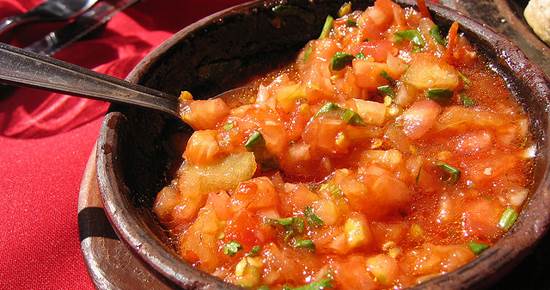Livening up salads, soup, meat, or fresh bread rolls, a good pebre is the hallmark of a Chilean kitchen, and a delicious vegetarian treat.
A satisfying blend of spice, salt and sour, pebre brings a fresh kick of cilantro and raw onion to liven up the flavors of a grilled steak, simple salad, or choripan. The choripan is most foreigners’ gateway introduction to pebre: the ubiquitous Chilean party food is usually served with a heaping portion of pebre atop the chorizo sausage and marraqueta roll of bread. But pebre is so much more than choripan-topping: once you start making this easy fresh sauce, you’ll find an infinite number of ways to put it to use in your kitchen. Here, we offer a very simple recipe for a very delicious way to spice up your next meal.
The (Highly-Subjective) Perfect Pebre Serves: six choripan consumers
Ingredients: 4 tomatoes, peeled and diced 1 medium-sized yellow onion, finely chopped 1-2 cloves of garlic, diced (look for the purple, long-neck garlic in Chile) 1 small bunch of cilantro, finely chopped 1 green aji chili pepper, diced 1 tsp of neutral vegetable oil 1 tbsp of lemon juice Salt, to taste Optional: merkén, the Mapuche spice blend of roasted red chili peppers and coriander seeds
Throw the peeled, diced tomatoes into a medium-sized mixing bowl and gently press with the blunt side of a spoon, so that there is a good amount of fresh juice buoying the diced tomato. Add the chopped onion, garlic, and cilantro and stir thoroughly. Add a portion of the diced aji chili pepper, and taste for spiciness. Keep adding aji little by little until you’ve reached your desired level of spice. Add the oil, lemon juice and salt, to taste. If you’re looking for an extra Chilean touch, throw in a pinch of the smoky merkén.
Substitutes outside Chile One of the best aspects of pebre is its highly flexible capacity: the main ingredients are both economical and easy to find at any Chilean feria market. Still, the aji chili pepper and the merkén can be hard to find outside the national borders, and a perfect pebre abroad will require a bit of experimentation to get the best result. The aji chili pepper has a lovely citrus flavor to its spiciness, which is hard to forget once you’ve tried it once – even if it’s not as fatally spicy as some of the Peruvian and Mexican peppers. If you’re looking for a substitute, try a small amount of a fresh habanero pepper, or whichever fresh chili pepper you most commonly use in order to best gauge spiciness. If you’re a merkén fanatic, it’s possible to make a substitution with the spices in your pantry: in a pinch, try using a bit of paprika, a bit of coriander and some chili flakes. And say you don’t have any fresh, ripe, in-season tomatoes. Don’t bother slicing up any of those tasteless, colorless imitations during winter. You can make a delicious pebre without tomatoes – just add extra lemon juice for acidity and merkén for a bit of color.
Pairing your perfect pebre with food and drink A good pebre will shine up even a day-old piece of bread, but why not stretch the limits of the imagination? Serve alongside a freshly-grilled steak, with a baked potato, fresh salad and a glass of carmenere, Chile’s signature red wine. Or, scoop a spoonful of the fresh Chilean salsa onto a steaming heap of seafood and shellfish in a traditional cocimiento or paila marina, with a hunk of fresh-baked bread and a nice glass of Chilean white. And of course, the choripan: carefully load up your chorizo with pebre, and wash down with a quality Chilean microbrew. For a true vegetarian meal, try serving pebre with some chopped up avocado over a bed of quinoa, the delicious and nutritious South American cereal grain. Or use as a salad dressing with fresh lettuce, crumbled hard-boiled eggs and substitute extra virgen olive oil for the neutral vegetable oil in the recipe.



